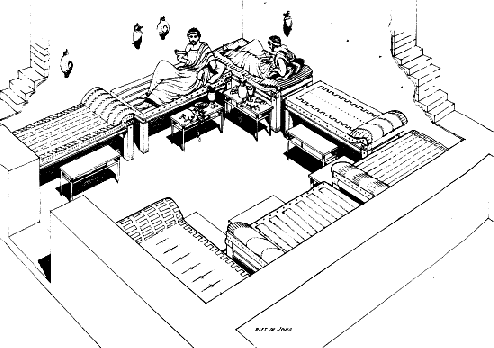|
By Christopher Xenopoulos Janus
As we know from Plato and other writers, ancient Greeks much loved to have drinking parties or symposiums – and most any excuse could be used to party; a birth, marriage, or death, the arrival or departure of a loved one from abroad, a feast day or merely a change in seasons. Actually in most cases, however, no purpose was required.
The ancient Greeks loved to party. The drinking party or symposium was not however the ancient equivalent to a few guys getting together to pass the breeze and down a few drinks. On the contrary, it was a highly ritualized institution with its own precise and time-hallowed rules. Plutarch described the drinking party as “a passing of time over wine, which guided by gracious behavior, ends in friendship.”
It was customary for the host to inscribe the names of his guests on a wax tablet, together with the day and hour appointed for the symposium and then hand the tablet to a slave who would make the rounds of the guests’ houses. The usual hour for convening was the ninth. Generally, the ideal number of guests was nine, including the host. In Athens in the fourth century B.C., however, the symposia grew so large that it became necessary to appoint a commission to insure that the number of guest did not exceed the legal limit. Since wives and daughters were not permitted to attend the symposia, the only females present were hired companions known as hetairaia.
The growing importance of the symposium was such that, from the fourth century B.C. onward, well-appointed houses possessed a special room for reclining and drinking known as an andron or men’s quarters. An andron can be identified in the archaeological record by its off center doorway, so located in order to enable the room to accommodate the couches, which were arranged along side each other and set against the walls. The basic andron held four couches, though some were considerably larger. The couches were made of either wood or stone. In front of each was a three-legged on which food was laid out and the drinkers placed their cups. As private houses became more elegant, androns acquired mosiac floors and their walls were hung with tapestries.

There were strict rules to which participants were required to adhere. The enforcement of these rules was in the hands of the symposiarch, or master of drinking. The ideal symposiarch according to Plutarch, had to be the “quintessence of conviviality,” neither inclined to drunkenness nor averse to drinking,. He had to be aware how each of his fellow symposiasts was affected by wine in order to determine what was conductive to the promotion of good cheer. He should be cordial and friendly, and objectionable to no one…Election to this office was made by a throw of dice, which meant it generally fell to one of the guests. The symposiarch had the authority to inflict a penalty in any drinker who infringed on the rules. In exceptional circumstances he could even order a guest to depart. As the Greeks did not drink undiluted wine, his inuagural duty was to determine the proportion of parts of wine to water – an important decision that would affect the tone of the whole evening. In addition, he decreed how many cups should be drunk, since only on rare occasions symposiasts permitted to drink as much or as little as they wished. The purpose behind this rule was to ensure that everyone attained approximately the same degree of inebriation. Finally the symposiarch arranged the entertainment and fixed penalties for those who failed to distinguish themselves in the games and competitions.
Despite these precautions, however, much no doubt happened that was not in accordance with the rules. A popular Greek saying “I hate a drinker with a good memory,” suggest that whatever was said or done by a symposiast when under the influence of alcohol was not to be held against him when he sobered up.
For everyday use, the Greeks drank out of glazed, undecorated mugs. The well-to-do, however possessed a special set of drinking cups and wine containers, which they reserved for use at a symposium.
Basic drinking equipment included a dozen or so kylikes or drinking mugs, a krater or mixing bowl, a psychter or wine cooler. An oinochoe or jug for pouring wine and a hydria or jug for pouring water. The pottery was frequently decorated with figured scenes, often of a very refined draughtmanship. These scenes provide a major source of information about conduct at these gatherings.
Finally, as Plato advises us, though the Greeks just loved to party, the drinking and entertainment, the symposium basically had a serious purpose. The purpose was serious conversation. In the midst of all the drinking philosophical questions were examined: What was the purpose of life? What is justice and truth? Can we live under unconditional loyalty? Are the gods to be trusted? Are women really inferior? Is drinking the answer? Many of Plato’s dialogues including the symposium were first conceived in a drinking party when questions asked and the tongue freed by wine would speak.
At the conclusion of a symposium, or when moving from one symposium to another, it was customary for drinkers to komazein, or to roam about her streets in a gang. It was just such a gang or komastai, as Plato writes in The Symposium “Order went out of the window and they compelled everyone to drink huge quantities of wine.” Assaults by drunken komastai were not uncommon. It became a stock joke that the worst behaved guests at a symposium were the philosophers! This amused Socrates though he, himself was not a serious drinker and was always at the center of the philosophical discussions.
|
About the Author
Educated at Harvard and Oxford, Christopher Xenopoulos Janus started his writing career as a reporter for the Chicago Daily News. Later he became a special writer for The New York Times Sunday News Magazine section where the late Lester Markel was his editor. During World War II, Janus joined the Department of State serving in Washington, Cairo and Athens on Greek War Relief and Rehabilitation programs. This experience had a great influence on his writing.
After World War II, the author was involved in various entrepreneurial experiences. At one time he owned Adolph Hitler's Mercedes Benz and toured it through the United States. He was an Investment Banker, but always took the time to be involved in the world around him.
Since his retirement from business, the author has devoted his time to writing, publishing and traveling. He founded and published the widely acclaimed Greek Heritage, The American Quarterly of Greek Culture, and with William Brashler wrote Search for Peking Man (Macmillan 1975). Janus' novel Miss Fourth of July, Goodbye has been filmed by Disney Productions. Around the World in 90 Years reflects much of the author's own warm and caring philosophy of life embodying unconditional loyalties and boundless enthusiasm. They feature a strong sense of self-reliance and the courage and wisdom to be interested in everything. Yet, as his mentor, George Santayana once cautioned the author: "Don't be awed by anything."
Most recently, the prestigious American Hellenic Institute Foundation of Washington, D.C. awarded its Hellenic Heritage Lifetime Achievement Award to Christopher Xenopoulos Janus.
Mr. Janus is the author of numerous articles appearing on HCS. Readers are invited to view them in a special section, Janus Articles and Publications, of our archives for his distinguished works.
|



